Lepcis Magna, Cardo
Lepcis Magna: Phoenician colony, later part of the Carthaginian empire, the kingdom of Massinissa, and the Roman empire. Its most famous son was the emperor Septimius Severus (r.193-211).
Cardo
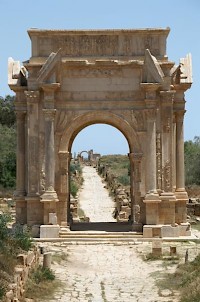
As long as the Romans planned their cities, they were inspired by gridiron plans. The ideal Romen city looked like a chessboard, with building blocks (insulae) on the fields, and in the center a forum, a square that was at the same time the city's commercial, religious, and administrative center. Here, the two main roads intersected: the Cardo Maximus and the Decumanus Maximus.
Of course, practical considerations were always more important than the perfect blueprint. In Lepcis Magna, the engineers found an already existent urban settlement, in which the main temples were located close to the sea and at least one market appears to have been near a city gate. However, when the Roman engineers had to add new quarters - and Lepcis was a boom town in the Roman age - they used their customary blueprint, and a Cardo and Decumanus were created. The first one ran from the southwest to the northeast and continued along the old market (the Macellum) to the temple area.
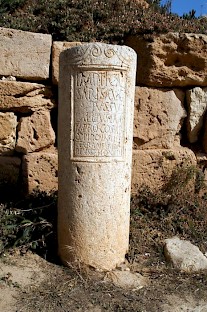
The other street, today called the Decumanus, was in fact the main road along the North-African coast, which began in Alexandria, continued through the Cyrenaica, reached Lepcis Magna, and continued to Oea, Sabratha, Carthage, and beyond. It passed along Lepcis, and the crossroads of the Cardo and Decumanus were therefore a little bit (some 350 m) outside the old city.
The crossing is now dominated by the Arch of Septimius Severus, but was once marked by this simple milestone only. It mentions that a Roman named Lucius Aelius Lamia, the governor of Africa, under orders from the emperor Tiberius (r.14-37), had constructed the road, and that it continued for forty-four miles (sixty-six kilometers) into the surrounding countryside, to the sanctuary of Ammon at Mesphe (Medina Doga). We know that Lucius Aelius Lamia was governor of Africa in 14-17.
Because the Cardo was the main artial road, it was well suited to erect monuments, where any visitor would see them. A remarkable example is the Monument of Gavius Macer, a commander of the Third Legion Augusta, which was built shortly after the construction of the Cardo. Of another inscription, only a fragment remains: it mentions a man named Scipio, who was the commander of a subunit of the Ninth Legion Hispana that supported the Third during the war against Tacfarinas.note
Among the other monuments were a fountain, the Arch of Trajan, and a statue of a little elephant, which is now in the Museum of Lepcis Magna. Beyond the Arch of Trajan and the elephant, there is a little dip in the road, which probably marks the place where one would have entered the pre-Roman city. The next monument is the Arch of Tiberius, which is close to the entrance of Macellum. There are no monuments beyond this point; if you continue along the road, you will arrive - after passing through the Byzantine Gate - near the temple area.
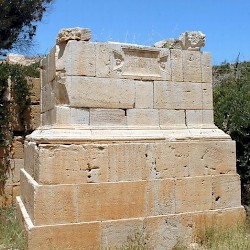 Lepcis Magna, Monument for Gaius Macer |
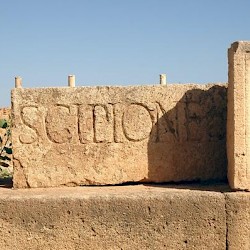 Lepcis Magna, Cardo, Inscription of Scipio |
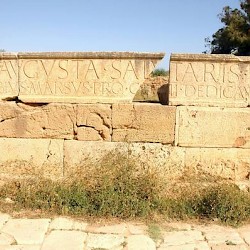 Lepcis Magna, Cardo, dedication to Augusta Salutaris |
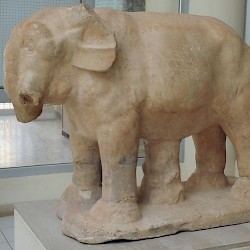 Lepcis Magna, Cardo, elephant |
The inscription that is known as "CIL 8.25844" appears to have been part of an arch that was later demolished. It informs us that one Gaius Vibius Marsus in his third year as governor dedicated something to Augusta Salutaris. This last title, extremely rare, is probably a variant on Salus Augusti, the health of the emperor.
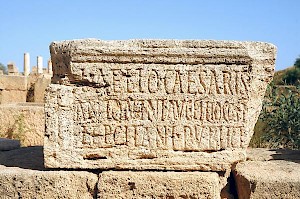
Finally, there is an inscription that says that a monument was, on behalf of the Lepcitanians, dedicated to Lucius Aelius, consul for the second time, son of Caesar Antoninus Augustus. This is a reference to the emperor known as Lucius Verus, who was the son of Lucius Aelius, had been adopted by Antoninus Pius, and was officially known as Lucius Aelius Aurelius Commodus. When he became emperor in March 161, he choose the name Lucius Verus. This inscription was probably made after he had become consul for the second time (1 January 161), and before the Lepcitanians heard that Antoninus was dead, and had been succeeded by Marcus Aurelius and Lucius Aelius, and that the latter had accepted a different name.